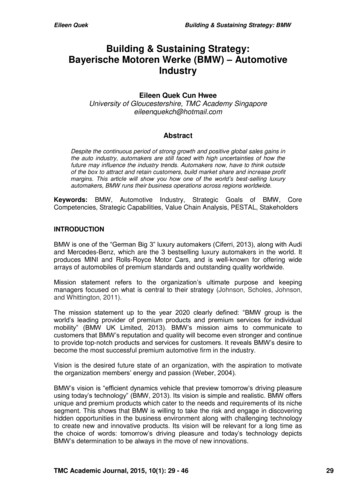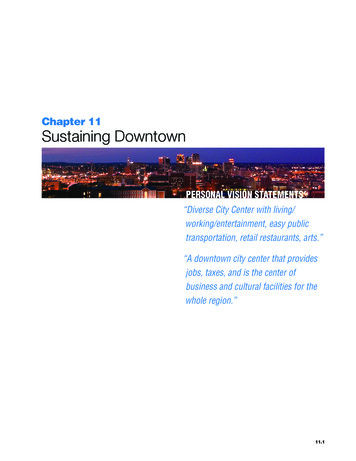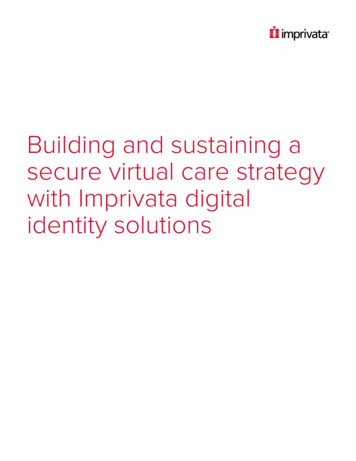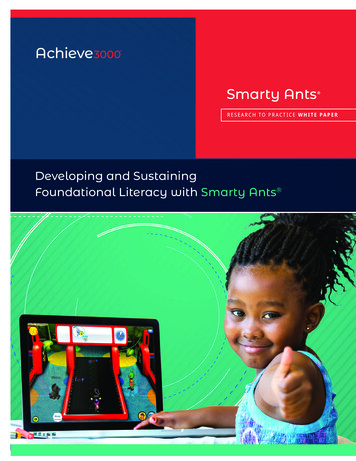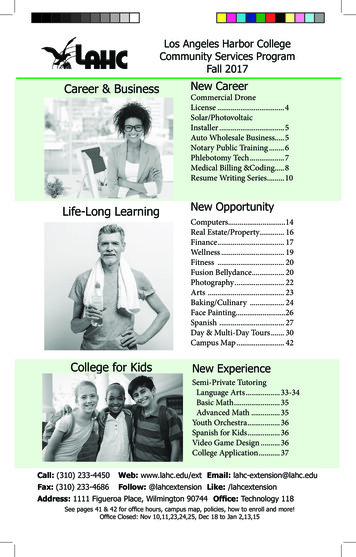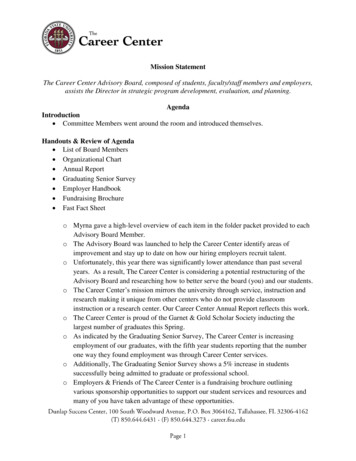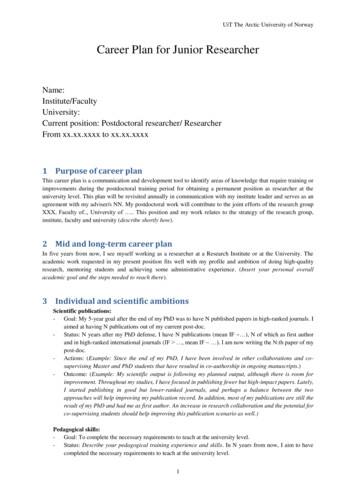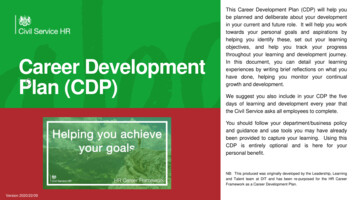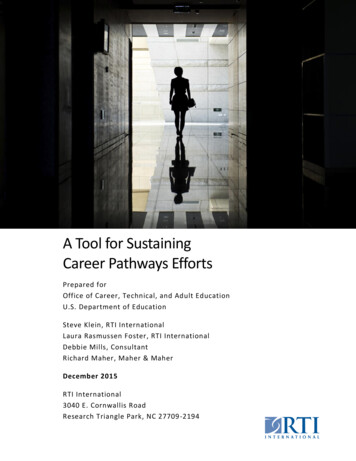
Transcription
A Tool for SustainingCareer Pathways EffortsPrepared forOffice of Career, Technical, and Adult EducationU.S. Department of EducationSteve Klein, RTI InternationalLaura Rasmussen Foster, RTI InternationalDebbie Mills, ConsultantRichard Maher, Maher & MaherDecember 2015RTI International3040 E. Cornwallis RoadResearch Triangle Park, NC 27709 -2194
The Advancing Career and Technical Education (CTE) in State and Local Career Pathways projectwas funded by the U.S. Department Education, Office of Career, Technical, and Adult Educationunder Contract No. ED-VAE-12-C-0068 and directed by Jobs for the Future.RTI International authored this publication for the U.S. Department of Education, Office ofCareer, Technical, and Adult Education. The content of this publication and the views expressedherein do not necessarily represent the positions or policies of the Department of Education.No official endorsement by the U.S. Department of Education of any product, commodity,service, or enterprise mentioned in this publication is intended or should be inferred.For the reader’s convenience, this publication contains information about and from outsideorganizations, including hyperlinks and URLs. Inclusion of such information does not constitutethe Department’s endorsement.This report is in the public domain. Authorization to reproduce it in whole or in part is granted.While permission to reprint this publication is not necessary, the citation should be: U.S.Department of Education, Office of Career, Technical, and Adult Education, A Tool forSustaining Career Pathways Efforts. Washington, D.C.: 2015: Klein, Steve, Laura RasmussenFoster, Debbie Mills, and Richard Maher.This report is available at: http://www.cte.ed.govDecember 2015RTI International3040 East Cornwallis RoadP.O. Box 12194Research Triangle Park, NC 27709-2194
TABLE OF CONTENTSList of Abbreviations . ivIntroduction .1Implications of Organizational Change Management Theory . 3I. Craft a Compelling Vision to Build Support for Change.6Envision Sustainability . 6Establish Management Structures and Supports . 7Build a Common Understanding . 8Communicate the Vision . 9Checklist .10II. Engage Partners and Stakeholders in the Change Process .11Engage a Broad Range of Partners .11Promote Long-Term Employer Engagement.12Checklist .13III. Adopt New Behaviors, Practices, and Processes.14Formalize and Continually Reinforce Partner Roles .14Create an Infrastructure for Partnership Communications .15Connect to Supportive Legislation and Policies .18Secure Long-Term Funding and Other Support .19Measuring and Sharing System Results .19Checklist .20Conclusion .21References .22Resources .23Appendix A: Career Pathways Sustainability Checklist.27Craft a Compelling Vision to Build Support for Change .27Engage Partners and Stakeholders in the Change Process .28Adopt New Behaviors, Practices, and Processes .29iii
LIST OF ABBREVIATIONSCTEcareer and technical educationGWDCGovernor’s Workforce Development CouncilLINCSLiteracy Information and Communication SystemMOUmemorandum of understandingOCTAEOffice of Career, Technical, and Adult EducationPOSprograms of studyRAMPRegional Advanced Manufacturing PartnershipREBRegional Employment BoardWIOAWorkforce Innovation and Opportunity Activ
A Tool for SustainingCareer Pathways EffortsINTRODUCTIONCareer pathways leverage education, workforce development, and social service supports tohelp people obtain the skills they need to find employment and advance in their careers.Fundamentally, a career pathways system is about the coordination of people and resources. Itis about changing the way education and training are organized and delivered—aligningprogramming, financing, and services within and across providers to smooth individuals’transitions into and out of education and training programs and employment. Recognizing thepotential benefits that a comprehensive career pathways system can offer, the federalgovernment, states, and an increasing number of communities—in collaboration withfoundations, community-based organizations, and employers—are investing significantresources to support the design and expansion of these comprehensive systems to serve youthand adults.As states and local communities move from program start-up toward implementation,strategies are needed to sustain the essential program and systems changes that will bemade along the way. Sustainability efforts should be integrated into career pathways systemdevelopment and implementation efforts from the outset to ensure systems are robust andpositioned for longevity.This paper outlines key considerations for putting career pathways into operation and providesa checklist of action items that states or local communities can use to assess the status of theirsustainability efforts. It draws in part from research on change management theory, which hasproduced strategies for sustaining organizational shifts. To help illustrate these points, thepaper draws on lessons learned from states participating in the Advancing Career and TechnicalEducation in State and Local Career Pathways Systems project, a three-year initiative funded bythe U.S. Department of Education, Office of Career, Technical, and Adult Education (OCTAE).1
Advancing Career and Technical Education in State and Local Career Pathways SystemsProject work focused on aligning states’ career and technical education (CTE) programsof study (POS) with on-going state and local efforts to develop career pathways systems.Five states (Colorado, Kansas, Massachusetts, Minnesota, and Oregon), selected througha competitive process, received support from coaches and subject matter experts, withtheir efforts guided by an Integrated Model for the Provision of Technical Assistance(Jobs for the Future 2014).The model combines six elements for developing career pathways from the U.S.Departments of Labor, Education, and Health and Human Services (shown in Figure 1)with a framework for the establishment of CTE POS from OCTAE (U.S. Department ofLabor 2015; U.S. Department of Education 2015).As states and local communities carry out these actions to establish career pathwayssystems, it is important that strategies for sustaining the resulting systems changes beembedded in all development and implementation undertakings, so that careerpathways approaches become the new way of doing business over time.Figure 1. Career Pathways: Six Key Elements2
States’ work in the Advancing Career and Technical Education in State and LocalCareer Pathways Systems project centered on connecting CTE POS to existingcareer pathways systems. A CTE POS describes a sequenced progression ofcourses that span secondary and postsecondary education. Students participatingin such programs are expected to master rigorous academic and technical contentthat is aligned to state standards. High school students also have the option ofearning dual credit that may be applied toward their collegiate studies. Althoughthey operate as a separate program with a specific set of objectives, state CTEPOS are an essential, contributing component of a career pathways system.Implications of Organizational Change Management TheoryResearch on change management offers a helpful lens for viewingsustainability in the context of career pathways systems. Inparticular, the literature highlights the importance of planning forsustainability on Day 1 of systems planning and operation, andbuilding and sustaining the cultural change that such work entails.Managing forsustainability meansmanaging forchange, and thatbegins on Day 1.The science of industrial-organizational psychology, and theleading change theorists it has produced, speak of “managingchange” not only as a way of breaking down resistance to new ideas but, importantly, as a wayof sustaining change by anchoring it in organizational culture. Two leading advocates ofevidence-based approaches to change management—Kurt Lewin and John Kotter—have putforward models that offer a roadmap to sustainability. Strategies contained within thesemodels can be used to frame work on pathways development in the context of a larger changemanagement initiative.Kurt Lewin, recognized as the founder of social psychology, studied the forces that driveorganizational change. Based on his research findings, in 1947, Lewin advanced a three-stagetheory of change that describes the factors businesses must address if they are to transformbehavior (Medley 2008). Key steps include unfreezing to prepare to take action; transitioning tomove toward a new equilibrium; and refreezing to reinforce newly established norms. Althoughdisarmingly simple, Lewin’s model has endured because it effectively describes the factors thatdrive human behavior and, in so doing, provides a framework for anticipating, planning, anddirecting change.3
John Kotter is a contemporary expert in institutional transformation and change management.While a professor at the Harvard Business School, Kotter began researching companies andtheir leaders to uncover why only a small percentage of firms ultimately achieved their businessobjectives. In 1995, Kotter published “Leading Change: Why Transformation Efforts Fail” in theHarvard Business Review, putting forward an eight-step process for coordinating institutionalchange initiatives (1995).1 Designed to promote companywide buy-in to the change process,Kotter’s eight-step model offers a comprehensive, strategic process for preparing organizationsto transform.Although the two models differ in their characterization of the change process and the mannerin which it occurs, they share some essential features (Table 1). For example, Lewin’s approachto “unfreeze” is directed at lowering organizational resistance to change. This may occur bychallenging staff to question their existing business model and consider new approaches. Kotterexpands upon this concept by identifying a consecutive set of steps that build collective supportfor transformative change. This may include conducting an objective assessment of theenvironment in which an organization or system operates and sharing the information withstaff to help them appreciate the competitive realities that they face.While both Lewin and Kotter focused their work at the organizational level, the concepts theyidentified are transferable to any human services system and therefore to our focus on careerpathways sustainability efforts. A functional career pathways system consists of multipleagencies with differing missions, all sharing a common goal of preparing individuals for careerand life success. In a sense, a career pathways system is like a large corporation: individual unitsmay be focused on differing aspects of the business, but each contributes to its larger success.1Kotter’s 8-Step Process for Leading Change. Kotter International -step-process-for-leading-change/.4
Table 1. Comparison of Lewin’s and Kotter’s Change Theory ModelsKurt Lewin’s 3-Phase Change TheoryJohn Kotter’s 8-Step ProcessUnfreeze1. Establish a sense of urgency2. Create a guiding coalitionPrepare to move away from the status quo3. Develop a vision and strategy4. Communicate the change visionTransition5. Empower broad-based action6. Generate short-term winsDevise strategies and take actions to changefrom the current condition7. Consolidate gains and make more changeRefreeze8. Anchor new approaches in the cultureImplement changes based on performanceexpectations and organizational cultureFor our purposes, the key tenets of these models can be distilled into three critical factors that,when addressed early and intentionally, can contribute to career pathways sustainability: craft (and agree upon) a compelling vision to build support for change, engage partners and stakeholders in the change process, and adopt new behaviors, practices, and processes.The following sections describe approaches that states and local communities can take tosustain career pathways systems. This paper is organized by the three factors, described above,that contribute to sustainability, and draws on examples provided by the Advancing Career andTechnical Education in State and Local Career Pathways Systems states. Sustainability checklistsare listed at the end of each section, with a complete checklist included in Appendix A. You canuse these checklists to help your state or local community integrate sustainability strategiesinto its career pathways system development efforts.5
I. CRAFT A COMPELLING VISION TO BUILD SUPPORT FOR CHANGEA robust career pathways system aligns education and training services offered by a range ofstate and local agencies, augmented with support from regional or local community groups andemployers. Pathways systems are characterized by their distributed authority and network ofpeople and relationships. No one person or state agency has singular oversight; consequently, awell-designed system is one in which organizations work together—aligning services, supports,and resources—to smooth individuals’ transition into and out of education and trainingprograms.Securing buy-in from pathways partners requires that state and/or local leaders articulate andcommunicate a clear and compelling vision of what a career pathways system is and what it canaccomplish. Ultimately, this vision will unite individual partners and organizations, compellingthem to pursue the larger goals of a pathways system while still attending to their ownprogrammatic goals and priorities. Addressing longstanding organizational norms and buildingenthusiasm for change are critical first steps in the transformative process.Envision SustainabilityBecause a true career pathways system is not housed within an individual entity, state and localleaders must collaborate to make a call to action that cuts across agency lines. At the federallevel, the urgency of this vision has been articulated by the U.S. Departments of Education,Labor, and Health and Human Services, which issued a joint letter of support and a proposedframework for the establishment of career pathways, demonstrating a robust federalcommitment to pathways development.“[A career pathways system is] a series of connected education and trainingstrategies and support services that enable individuals to secure industry relevantcertification and obtain employment within an occupational area and to advanceto higher levels of future education and employment.”—U.S. Departments of Education, Labor, and Health and Human Services (2012)6
Identifying System Progress and GoalsLink to career readinessassessmentStates participating in the Advancing Career and Technical Education inState and Local Career Pathways Systems project started bycompleting a readiness assessment to determine their progresstoward developing a comprehensive career pathways system. Criteriawere based on an Integrated Model for the Provision of TechnicalAssistance that includes CTE POS (see Text Box 1, page 4), whichidentifies six key elements or actions that states and local communitiescan take to establish pathways systems. State teams rated theirprogress along a continuum for the development of career pathways,informing pathways design and implementation efforts. The endgoal—sustainability—was included as a measure of progress in theassessment. This exercise required system leaders not only to assesstheir progress but also to identify system goals, such as adopting ashared cross-agency vision to guide system development and promotesustainability from the start.Establish Management Structures and SupportsEngaging the right individuals in the pursuit of a common vision and shared set of goals iscrucial to maintaining pathways over time. While support from visible, high-level leaders isnecessary to endorse the system and provide impetus needed for systems change, ongoingoversight typically comes from a steering committee, made up of representatives fromdifferent state or local agencies, employers, community organizations, and other stakeholdergroups. This pathways steering committee plays a critical role in articulating the cross-systemvision for career pathways and in securing the cross-agency commitment to make necessarysystem changes.7
Adopting a State-Level Infrastructure for Career Pathways PartnershipsLink to MinnesotaPartnership AdvisoryBriefTo promote its statewide vision for career pathways and to sustain effortsbegun under the Advancing Career and Technical Education in State and LocalCareer Pathways Systems project, Minnesota has identified the state’sGovernor’s Workforce Development Council (GWDC) as the entity that willlead career pathways systems implementation efforts going forward. Thestate council is charged with convening state leaders—drawn from business,education, workforce, labor, community organizations, and government underthe newly enacted Workforce Innovation and Opportunity Act (WIOA) —tohelp develop policies to promote a highly skilled workforce and economicgrowth. In 2015, to underscore the importance of career pathways to thestate’s continued economic development, the GWDC in Minnesota formed astanding Career Pathways Partnership committee. This committee willcontinue the work initiated through the state’s involvement in the project,with a focus on determining what a comprehensive career pathways systemlooks like in Minnesota, and aligning the multiple pathways efforts that areong
under Contract No. ED-VAE-12-C-0068 and directed by Jobs for the Future. RTI International authored this publication for the U.S. Department of Education, Office of Career, Technical, and Adult Education
